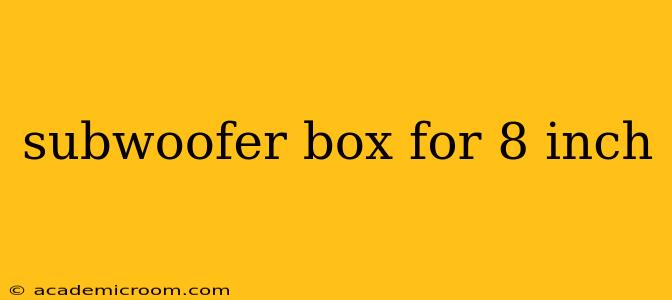Choosing the right subwoofer box is crucial for achieving optimal sound quality from your 8-inch subwoofer. A poorly designed enclosure can drastically reduce the bass response, leading to muddy sound and wasted potential. This comprehensive guide will walk you through the key considerations for building or buying a subwoofer box tailored to your 8-inch driver.
What Type of Enclosure Should I Use for My 8-Inch Subwoofer?
This is arguably the most important decision. There are several common enclosure types, each with its own characteristics:
-
Sealed (Acoustic Suspension): Sealed boxes are simple to build, offering tight, accurate bass with good transient response (how quickly the bass starts and stops). They generally handle less power than ported boxes of the same size but are less prone to distortion. Ideal for smaller spaces and applications where precise, clean bass is prioritized over sheer volume.
-
Ported (Bass Reflex): Ported boxes utilize a port (tube) to enhance bass output at specific frequencies. This results in louder bass, especially in the lower frequencies, but can be less accurate and more prone to distortion at higher volumes. Best suited for applications requiring maximum bass output in larger spaces.
-
Bandpass: Bandpass boxes are more complex and are generally used for specialized applications. They offer a very focused range of bass frequencies, and are less versatile than sealed or ported boxes. They are less common for home audio setups.
-
Horn: Horn loaded subwoofer enclosures direct the sound waves using a horn design to increase output. They are very efficient but are complex to design and build and often require more space.
The best type of enclosure depends on your priorities (loudness vs. accuracy) and your listening environment. For an 8-inch subwoofer, a sealed or ported enclosure is usually the most practical choice.
What Size Subwoofer Box Do I Need for My 8-Inch Subwoofer?
The optimal size of your subwoofer box is dependent on the type of enclosure and the specifications of your specific 8-inch subwoofer. The manufacturer's specifications will often include recommended enclosure volumes (usually in cubic feet or liters). Using these recommendations is crucial for achieving the best sound quality. If you're building your own box, you'll need to calculate the internal volume precisely. There are numerous online calculators available to assist with this calculation. Never guess! Improper sizing drastically impacts performance.
How Do I Calculate the Right Box Size for My 8-Inch Sub?
Calculating the correct box volume often involves using the subwoofer's Thiele-Small parameters (T/S parameters). These parameters describe the electrical and mechanical properties of the driver. Using these parameters allows for accurate predictions of the subwoofer's performance within different enclosure types. Many online calculators utilize these parameters, and some subwoofer manufacturers provide them in the driver's specifications.
What Materials Should I Use to Build My Subwoofer Box?
Common materials include:
-
Medium-Density Fiberboard (MDF): MDF is a popular choice because of its density, stiffness, and ability to provide a good seal.
-
Particle Board: Less expensive than MDF, but less rigid and more prone to resonance. Not ideal for high-quality applications.
-
Plywood: Can be used, but requires careful sealing to prevent leaks.
What Tools Do I Need to Build a Subwoofer Box?
Building a subwoofer box requires specific tools including:
-
Circular saw or jigsaw: For cutting the wood.
-
Drill: For pilot holes and screwing parts together.
-
Screws: Wood screws appropriate for the chosen material.
-
Wood glue: For a strong and airtight seal.
-
Measuring tape and square: For accurate measurements and cuts.
-
Clamps: To hold the pieces together while the glue dries.
-
Sandpaper: To smooth the edges and surfaces.
-
Wood filler: To fill any gaps or imperfections.
Can I Buy a Pre-Made Subwoofer Box for My 8-Inch Subwoofer?
Yes, many pre-made subwoofer boxes are available for purchase online and in audio stores. This is a convenient option if you lack the tools or skills to build your own. Make sure to check the internal volume and enclosure type (sealed or ported) to ensure compatibility with your 8-inch subwoofer.
By carefully considering these factors and taking the time to research your specific 8-inch subwoofer's requirements, you can build or choose a subwoofer box that will unleash its full potential and deliver the rich, powerful bass you desire. Remember, proper enclosure design is paramount for optimal subwoofer performance.
